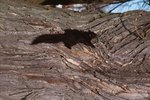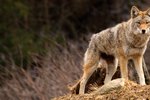
Most ground squirrels have cheek pouches, but flying and tree squirrels do not. African ground squirrels also lack cheek pouches. When they're present, cheek pouches sit just behind the front teeth on both sides of the face. A muscle in the pouch helps the squirrel empty it once it is back in its burrow, to feed to family members or save for later when food is scarce.
Chubby-Cheeked Ground Squirrels
Most ground squirrels do have cheek pockets. Antelope ground squirrels, rock squirrels, California ground squirrels and many others can be seen gnawing on grasses and munching on seeds, but all the while their cheeks are growing and growing. The size of their cheek pouches varies between types of squirrels. Ground squirrels tend to have larger cheek pouches, however, than some of the others in the squirrel family. To scientists, this means they use their pouches to store more food than those with smaller pouches.
Store-for-Later Chipmunks
Chipmunks are small members of the squirrel family. The phrase "chipmunk cheeks" -- used to describe a puffy-cheeked animal -- came from the look chipmunks are known for as they store ample amounts of food in their cheek pouches. It's easy to tell chipmunks from ground squirrels -- chipmunks are smaller and have large brown stripes from head to tail and narrower tails that tip up at the end. Although some ground squirrels also have stripes -- such as the thirteen-lined and golden-mantled ground squirrels -- only chipmunks have stripes on their faces, too.
Peppy Prairie Dogs
The perky "dogs" that are recognized by their tendency to pop up out of their burrows were nicknamed dogs because of their bark-like vocalizations. Actually, prairie dogs are members of the squirrel family. Like ground squirrels and chipmunks, prairie dogs also have cheek pouches to store food and take it back to their burrows for their families and for later use. Their use of cheek pouches isn't as well documented as that of ground squirrels and chipmunks, probably because it's difficult to catch prairie dogs in action before they dive back into their burrows.
Massive Marmots
Marmots are very large members of the squirrel family. The Alaskan marmot is usually dark brown or black, but can be white. It has a narrow range in northern Alaska, along the coast and in the Brooks Mountains, which means it isn't often observed by humans. The more common woodchuck -- also called a groundhog -- also has partially developed cheek pouches. Marmots do not use their cheek pouches much, though they may have at one time.
References
Resources
Photo Credits
-
Hemera Technologies/Photos.com/Getty Images
Writer Bio
Barbara Bean-Mellinger is an award-winning writer in the Washington, DC area. She writes nationally for newspapers, magazines and websites on topics including careers, education, women, marketing, advertising and more. She holds a Bachelor of Science from the University of Pittsburgh.



